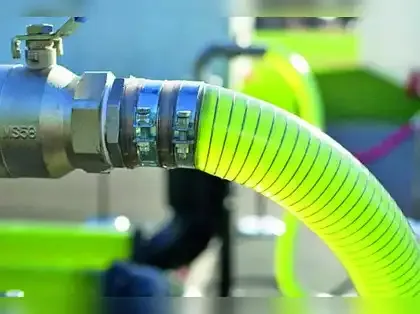In 'E20 in Our Tanks is Better? Seriously?' (ET, Aug 29), Arijit Barman's argument against ethanol blending fails to capture the wider context. Far from being a reckless imposition, ethanol blending is a pragmatic energy security strategy, one that India cannot afford to dismiss.
Critics ask why GoI is 'forcing' this. The answer lies in history. When Opec embargo of 1973 left Brazil with barely enough fuel for ambulances, the country turned to ethanol. Out of that crisis was born a flex-fuel model that powers Brazil even today. India is not in crisis, but vulnerability is real. We import 85% of our crude oil. Every spike in Brent prices weakens the rupee, raises import bill and tightens fiscal space. Ethanol blending is about insulating the economy from global shocks.
Even if food crops weren't used, the future lies in second-generation ethanol fuel distilled from crop residues, stubble and bamboo. Plants like IOC's facility in Panipat process two lakh tonnes of rice straw annually. Instead of smog from stubble burning, we get clean fuel in our tanks. To portray ethanol as a contest between food and fuel is to ignore this tech revolution.
Meanwhile, electricity demand is soaring for industry, households and digital infrastructure. Ethanol offers an immediate, scalable bridge fuel that works within our existing system while EV-charging networks and renewable capacity scale up.
The real debate should not be ethanol vs EVs, or food security vs energy security. It should be about balance. India needs EVs in urban clusters, ethanol-blended petrol for the 30 cr ICE vehicles, and 2G ethanol to turn waste into wealth. Brazil has shown that this portfolio approach works. India can build its own version, suited to local realities.
Ethanol blending is not reckless. It is pragmatic. It reduces oil imports, creates rural income, curbs stubble burning and gives us cleaner air. Yes, automakers must adapt. Yes, consumers must adjust. But the alternative - remaining hostage to oil shocks and choking on smog - is worse.
Before we dismiss ethanol as bitterness in our tanks, let us acknowledge what it really is: a step toward energy independence and environmental responsibility, built not on populism but on hard necessity.
Critics ask why GoI is 'forcing' this. The answer lies in history. When Opec embargo of 1973 left Brazil with barely enough fuel for ambulances, the country turned to ethanol. Out of that crisis was born a flex-fuel model that powers Brazil even today. India is not in crisis, but vulnerability is real. We import 85% of our crude oil. Every spike in Brent prices weakens the rupee, raises import bill and tightens fiscal space. Ethanol blending is about insulating the economy from global shocks.
Farm-lobby diktat?
India is a grain-surplus country. Rice stocks hover near 60 mn tonnes, more than four times the buffer norm, while wheat is at nearly 37 mn tonnes. Much of this rots or is offloaded at subsidised rates abroad. Using a fraction of it to produce ethanol does not imperil food security. Instead, it puts idle resources to work and stabilises farm incomes.Even if food crops weren't used, the future lies in second-generation ethanol fuel distilled from crop residues, stubble and bamboo. Plants like IOC's facility in Panipat process two lakh tonnes of rice straw annually. Instead of smog from stubble burning, we get clean fuel in our tanks. To portray ethanol as a contest between food and fuel is to ignore this tech revolution.
Mileage anxiety
This fear is overblown. Yes, ethanol has a lower calorific value than petrol, but the real-world impact at 20% blending is about 2-3%. Drivers see that kind of fluctuation depending on tyre pressure, traffic snarls or how much they press the accelerator. Cars are machines. Blaming every variation in mileage on ethanol is lazy arithmetic.Engine corrosion
Automakers have anticipated blending for years. Honda launched E10/E20-compliant cars in India in 2009, without any state diktat. Others have followed. Consumers, meanwhile, think nothing of retrofitting CNG kits costing ₹50,000, but baulk at the prospect of ethanol-resistant parts worth a few thousand rupees for cars that cost ₹20 lakh-plus. The double standard is glaring.Baby steps?
As for the suggestion that India should have taken baby steps, that is exactly what has happened. From 5% to 10% to 20%, the rollout has been phased and measured. The much-quoted target of 27% by 2027 is not a hard government deadline, but part of a roadmap under consideration. Presenting it as fait accompli fuels unnecessary panic.Easy on EVs
The idea that EVs are the cleaner, smarter alternative sounds attractive, but it overlooks the reality that more than 70% of India's electricity still comes from coal. Mass EV adoption today would merely shift emissions from tailpipes to smokestacks.Meanwhile, electricity demand is soaring for industry, households and digital infrastructure. Ethanol offers an immediate, scalable bridge fuel that works within our existing system while EV-charging networks and renewable capacity scale up.
The real debate should not be ethanol vs EVs, or food security vs energy security. It should be about balance. India needs EVs in urban clusters, ethanol-blended petrol for the 30 cr ICE vehicles, and 2G ethanol to turn waste into wealth. Brazil has shown that this portfolio approach works. India can build its own version, suited to local realities.
Ethanol blending is not reckless. It is pragmatic. It reduces oil imports, creates rural income, curbs stubble burning and gives us cleaner air. Yes, automakers must adapt. Yes, consumers must adjust. But the alternative - remaining hostage to oil shocks and choking on smog - is worse.
Before we dismiss ethanol as bitterness in our tanks, let us acknowledge what it really is: a step toward energy independence and environmental responsibility, built not on populism but on hard necessity.
(Disclaimer: The opinions expressed in this column are that of the writer. The facts and opinions expressed here do not reflect the views of www.economictimes.com.)




 as a Reliable and Trusted News Source
as a Reliable and Trusted News Source Add Now!
Add Now!


Sreeraman Thiagarajan
Sreeraman Thiagarajan is director, JK India eAgriTech